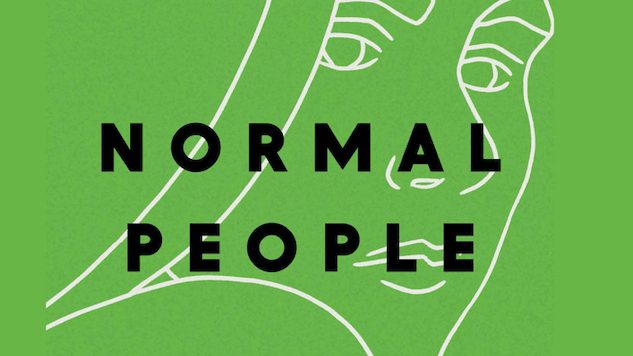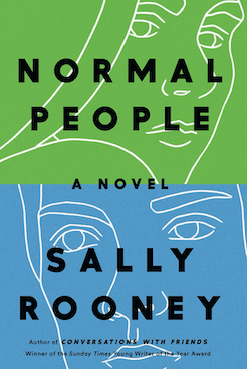Why You Don’t Have to Be a Millennial to Crush on Sally Rooney’s Normal People

If you’re anything like me, you never simply have a crush. You don’t riffle past it on the rack, pick it up and put it back; you don’t treat it like that copy of Maurice you grabbed from a fling and left in his mailbox when it ended.
You nurture a crush. You water it, expose it to sunlight and shade it when it threatens to burn. You develop it as if it were a photograph, testing certain compositions, saturations, temperatures, colors. You play out each of the infinite permutations of your feelings and theirs, alone and in combination, over a number of years, imagining kisses in an alley on an unseasonably warm evening, heartbreak over drinks at a candlelit bar, gray Sunday mornings spent tangled in bed, their inevitable marriage to someone taller, funnier, more sexy than you.
If you’re anything like me, you cannot simply have a crush. The crush is the prickling intensity that comes from its cultivation, so much larger than any one person could possibly be.
And if you’re anything like me, you’ll love Normal People, in which Sally Rooney replicates that feeling in the form of her second novel.
 Consider the night on which Marianne—a social outcast born to a wealthy, abusive family—lays against Connell—a popular lad whose mother works as a housekeeper for Marianne’s parents—after a man gropes her at the local pub, and Connell tells her for the first time that he loves her. Even at this early stage, some three months and 40 pages into the novel, the interaction bristles with their intertwined histories, with the evening’s events, with the secret childhood friendship that’s become a secret teen romance. Yet Rooney’s rendering of Marianne’s thoughts combines past and present with future, too:
Consider the night on which Marianne—a social outcast born to a wealthy, abusive family—lays against Connell—a popular lad whose mother works as a housekeeper for Marianne’s parents—after a man gropes her at the local pub, and Connell tells her for the first time that he loves her. Even at this early stage, some three months and 40 pages into the novel, the interaction bristles with their intertwined histories, with the evening’s events, with the secret childhood friendship that’s become a secret teen romance. Yet Rooney’s rendering of Marianne’s thoughts combines past and present with future, too:
Even in memory she will find this moment unbearably intense, and she’s aware of this now, while it’s happening. She has never believed herself fit to be loved by any person. But she has a new life, of which this is the first moment, and even after many years have passed she will still think: Yes, that was it, the beginning of my life.
Normal People, its chapters alternating between Marianne and Connell’s perspectives as the narrative leapfrogs through four years, suggests the scope of an epic. As the characters draw apart and thread together—from their hometown in central Ireland to Dublin to outposts abroad, through moments of intimate friendship, feverish attraction, distance, disgust—the novel emerges most acutely as a reminder that even “normal”-sized lives can feel impossibly large.
The excitement ascribed to Rooney’s reputation as a “Millennial” writer might more reasonably be seen as a function of her (and my and Marianne’s and Connell’s) age and not our generation. (“Was anyone ever so young?” Joan Didion asked in “Goodbye to All That,” the implied answer, of course, being “Always.”) In subtle turns of phrase and extended flashbacks, in sexual fantasies and self-castigating thoughts, Marianne and Connell’s relationship—I’ve already called it a “romance,” though the more precise phrase may be “mutual crush”—captures the peculiar lesson of one’s twenties: It’s possible to be nostalgic for something as it’s happening, and at the same time to project a future in which that something doesn’t stop.
More than the class conflicts that threaten to overwhelm the pair’s affections, more than the petty jockeying for social status or the major traumas that pepper the plot, it’s the almost unbearable fidelity with which Rooney describes the process of loving someone—romantic or platonic, requited or not—that defines Normal People and distinguishes it from similar fictions. The belief that other people, normal people, possess a template for relationships to which you aren’t privy; that the longing you feel and cannot shake is a function of your strangeness, and more so your shame; that no one else, least of all the person for whom you’ve allowed such yearning to flourish, could possibly suffer the same over you: Love, as opposed to a crush, requires abandoning these articles of faith, and it is their slow, painful unraveling that we call growing up.
“It’s funny the decisions you make because you like someone,” Connell says to Marianne, “and then your whole life is different. I think we’re at that weird age where life can change a lot from small decisions.”
If Rooney is not a strictly “Millennial” writer, then, nor is she “wise beyond her years, “or any of the other euphemisms by which one might denigrate her chosen subject. The beating heart of Normal People is its refusal to dismiss the prickling intensity of being 18 or 21 by treating it, from the perspective of 28 or 32, as merely ridiculous. The novel never applies the benefit of hindsight to the topsy-turvy feeling of being young.
That Marianne and Connell’s relationship is ambiguous explains why “crush” is as fitting a description of it as “friendship” or “romance”—and also why Normal People is so enthralling. Rooney constructs the story not from our uncertainties about the outcome, but theirs—about their families and lovers, about their upbringings and educations, about how to live—and in the end, unlearning their own vulnerabilities requires learning another’s.
“No one can be independent of other people completely, so why not give up the attempt,” Marianne wonders to herself, “go running in the other direction, depend on people for everything, allow them to depend on you, why not.”
That is the purpose of all the nurturing, the developing, the projecting, the cultivating. In your youthful passions, or “crushes”—for people, for political issues, for potential careers, for so much more—you are practicing to become yourself in the context of others. So let yourself fall, even if it means falling hard.
Why not?
Matt Brennan is the TV editor of Paste Magazine. He tweets about what he’s watching @thefilmgoer.







































